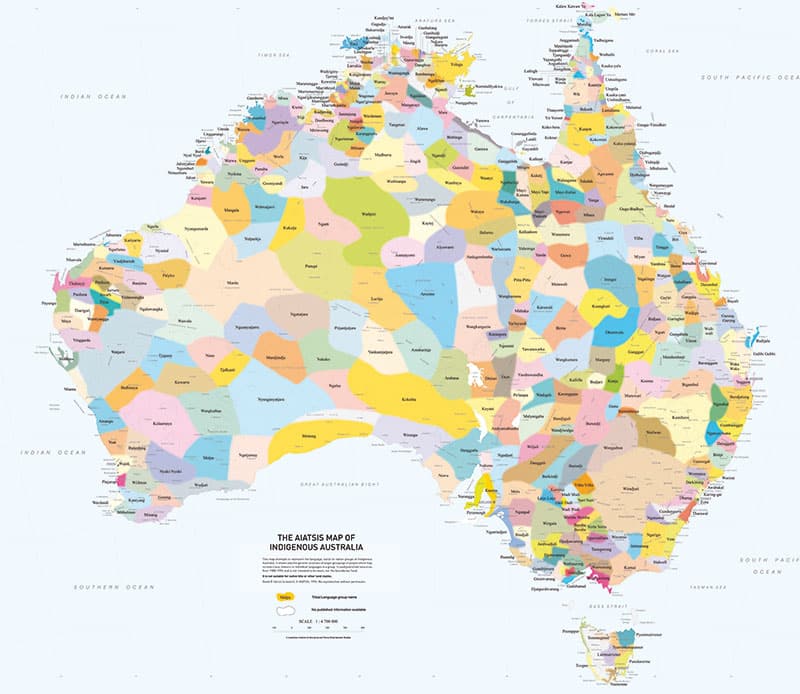When setting out on a journey – whether it be in your own state, Country or overseas – what is the first thing you reach for? If you are like us, we are guessing it’s the map! (whether that be print, digital, or the navigation system).
When traveling somewhere new, we often go with fresh eyes and ears and deepened curiosity for learning about the place we are visiting. What kinds of things do you intentionally discover and explore? Is it the terrain, environment, climate, attractions, culture, art, song or dance? What do you notice? What do you pay keen attention to?
What a fascinating experience it can be when we take our fresh ears and eyes when walking to the local park, shops, traveling to work, whatever it might be…
Learning About Indigenous Peoples and Languages Through Australia Maps
In Evolve’s cultural awareness training programs, participants are fascinated by the collection maps we share. Take a moment to look at the two maps below.
The first is that drawn by English explorer Matthew Flinders. It was an outline of the coast with no mention of the hundreds of Nations who habited the continent.
The second – the Aboriginal Language Map – attempts to represent all the language or tribal or nation groups of Indigenous people of Australia. It indicates general locations of larger groupings which may include smaller groups such as clans, dialects or individual Indigenous languages in a group. David R Horton is the creator of this mapping system. It’s based on linguistic research and data gathered by Aboriginal Studies Press, AIATSIS and Auslig/Sinclair, Knight, Merz, (1996).

Enlarge
Matthew Flinders Map
Terra Australis or Australia

Take a good look at the second map (for an interactive version go to https://aiatsis.gov.au/explore/articles/aiatsis-map-indigenous-australia)
Questions to Ponder While Exploring the Language Map?
- What are your first impressions?
- Where is your attention drawn to?
- Do you know the Nation group for where you live or work?
- Do you know how to say “hello” in Aboriginal language?
When we ask this in our programs – common responses are:
- It is incredibly colourful!
- WOW – I had no idea there are that many groups
- The diversity and richness is amazing
Aboriginal people on the continent now known as ‘Australia’ are made up of peoples from the First Nations that all have their own specific names, and in many instances, speak/spoke their own specific language. This map shows 600 – 700 Nations. Of the languages, over 120 are spoken in the Country today, with many endangered.
Respecting the Indigenous Languages and People Whose Land You Are On
We invite you to use this resource as you would any other map when journeying. This doesn’t need to be a holiday – it could even be a trip to the local shop, within your state or interstate. Whose Country are you traveling to or through? What is their name? What can you find out about them?
This is an incredibly respectful thing to do.
And to go one further step, you can acknowledge the Traditional Owners on whose Country you live, work or travel. Think about when you visit someone’s home – the first thing you do is greet each other, and then you likely acknowledge your host with something like “Thank you for inviting me”.
An Acknowledgement of Country is similar in that you are acknowledging your host – the traditional owners on whose Country you stand. It is an acknowledgement of the Aboriginal or Torres Strait Islander community as the traditional owners of the land, and the special respect held for their Elders. It also allows non-Indigenous individuals an opportunity to share, support, and participate in Indigenous culture. This has enormous implications for our journey together on the road to reconciliation and our shared heritage as Australians.
But you don’t have to wait for an official occasion to give an acknowledgement. Just as you would acknowledge and thank the host of a home as a visitor, right now you can acknowledge the local people on whose land that you are living, traveling or working on. It could go something like this:
I acknowledge the Traditional Owners on the land I stand on today and pay my respect to their Elders, past and present.
If you do not know who the owners are, take a moment to check the map above.
And perhaps next time you are visiting somewhere different to where you live, you can find out who is your host, and acknowledge them from the heart.

1 Comment. Leave new
In solidarity with Julian Assange, in 2012 the Indigenous people of Australia offered him refuge on their lands, granting him a new Aboriginal Nations passport.